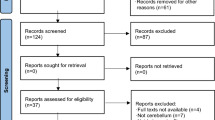Summary
Movement-associated cortical potentials (MP) associated with thumb-opposition or fist-clenching were studied in 20 patients with unilateral cerebral lesions and in 8 healthy subjects. MP was abnormal in 16 patients. The most frequent abnormality was an attenuation of the N component or readiness potential, recorded on the central region contralateral to the contracting muscle, on the affected hemisphere. The occurrence and severity of MP abnormalities seem to be influenced by an intensity and extension of the lesion, rather than by how much disability is present in the affected limb. There was no significant correlation between the abnormalities of MP and of EEG. The most useful index of MP for comparing two hemispheres was shown to be the amplitude and wave form of the N component or readiness potential contralateral to the contracting muscle.
Zusammenfassung
Corticale Potentiale, assoziiert mit Daumenopposition oder Faustmachen, wurden bei 20 Patienten mit unilateralen cerebralen Läsionen und bei 8 gesunden Männern studiert. Die bewegungsassoziierten, cerebralen Potentiale (MP) waren abnorm bei 16 Patienten. Die häufigste Abnormität war eine Depression der N-Komponente oder des Bereitschaftspotentiales, registriert über der Zentralregion kontralateral zum zusammenziehenden Muskel über der beschädigten Hemisphäre. Vorkommen und Grad der MP-Abnormitäten schienen mehr von einer Intensität und Extension der Läsion als von einem Störungsgrad der gestörten Hand beeinflußt zu sein. Keine bedeutende Korrelation war vorhanden zwischen den MP-Abnormitäten und den EEG-Abnormitäten. Der wirksamste Index der MP zum Vergleich beider Hemisphären war eine Amplitude und Wellenform der N-Komponente oder des Bereitschaftspotentiales kontralateral zum zusammenziehenden Muskel.
Similar content being viewed by others
References
Becker, W., Hoehne, O., Iwase, K., Kornhuber, H. H.: Bereitschaftspotential, prämotorische Positivierung und andere Hirnpotentiale bei sakkadischen Augenbewegungen. Vision Res. 12, 421–436 (1972)
Chiorini, J. R.: Slow potential changes from cat cortex and classical aversive conditioning. Electroenceph. clin. Neurophysiol. 26, 399–406 (1969)
Deecke, L., Scheid, P., Kornhuber, H. H.: Distribution of readiness potential, pre-motion positivity, and motor potential of the human cerebral cortex preceding voluntary finger movements. Exp. Brain Res. 7, 158–168 (1969)
Donchin, E., Otto, D., Gerbrandt, L. K., Pribram, K. H.: While a monkey waits: Electrocortical events recorded during the foreperiod of a reaction time study. Electroenceph. clin. Neurophysiol. 31, 115–127 (1971)
Gerbrandt, L. K., Goff, W. R., Smith, D. B.: Distribution of the human average movement potential. Electroenceph. clin. Neurophysiol. 34, 461–474 (1973)
Gilden, L., Vaughan, H. G., Jr., Costa, L. D.: Summated human EEG potentials with voluntary movement. Electroenceph. clin. Neurophysiol. 20, 433–438 (1966)
Irwin, D. A., Rebert, C. S.: Slow potential changes in cat brain during classical appetitive conditioning of jaw movements using two levels of reward. Electroenceph. clin. Neurophysiol. 28, 119–126 (1970)
Järvilehto, T., Fruhstorfer, H.: Differentiation between slow cortical potentials associated with motor and mental acts in man. Exp. Brain Res. 11, 309–317 (1970)
Karlin, L., Marty, M. J., Brauth, S. E., Mordkoff, A. M.: Auditory evoked potentials, motor potentials and reaction time. Electroenceph. clin. Neurophysiol. 31, 129–136 (1971)
Kornhuber, H. H., Deecke, L.: Hirnpotentialänderungen bei Willkürbewegungen und passiven Bewegungen des Menschen: Bereitschaftspotential und reafferente Potentiale. Pflügers Arch. ges. Physiol. 284, 1–17 (1965)
McAdam, D. W., Rubin, E. H.: Readiness potential, vertex positive wave, contingent negative variation and accuracy of perception. Electroenceph. clin. Neurophysiol. 30, 511–517 (1971)
McCallum, W. C., Cummins, B.: The effects of brain lesions on the contingent negative variation in neurosurgical patients. Electroenceph. clin. Neurophysiol. 35, 449–456 (1973)
Megirian, D., Burešová, O., Bureš, J., Dimond, S.: Electrophysiological correlates of discrete forelimb movements in rats. Electroenceph. clin. Neurophysiol. 36, 131–139 (1974)
Rebert, C. S.: Cortical and subcortical slow potentials in the monkey's brain during a preparatory interval. Electroenceph. clin. Neurophysiol. 33, 389–402 (1972)
Rebert, C. S., Irwin, D. A.: Slow potential changes in cat brain during classical appetitive and aversive conditioning of jaw movement. Electroenceph. clin. Neurophysiol. 27, 152–161 (1969)
Rosenfeld, J. P., Fox, S. S.: Movement-related macropotentials in cat cortex. Electroenceph. clin. Neurophysiol. 32, 75–80 (1972)
Shibasaki, H., Kato, M.: Movement-associated cortical potentials with unilateral and bilateral simultaneous hand movement. J. Neurol. 208, 191–199 (1975)
Skinner, J. E.: Abolition of a conditioned, surface-negative, cortical potential during cryogenic blockade of the non-specific thalamo-cortical system. Electroenceph. clin. Neurophysiol. 31, 197–209 (1971)
Timsit-Berthier, M., Delaunoy, J., Rousseau, J. C.: Slow potential changes in psychiatry. II. Motor potential. Electroenceph. clin. Neurophysiol. 35, 363–367 (1973)
Vaughan, H. G., Jr., Costa, L. D., Gilden, L., Schimmel, H.: Identification of sensory and motor components of cerebral activity in simple reaction time tasks. Proc. 73rd Conv. Amer. Psychol. Ass. 1, 179–180 (1965)
Vaughan, H. G., Jr., Costa, L. D., Ritter, W.: Topography of the human motor potential. Electroenceph. clin. Neurophysiol. 25, 1–10 (1968)
Vaughan, H. G., Jr., Gross, E. G., Bossom, J.: Cortical motor potential in monkeys before and after upper limb deafferentation. Exp. Neurol. 26, 253–262 (1970)
Wilke, J. T., Lansing, R. W.: Variations in the motor potential with force exerted during voluntary arm movements in man. Electroenceph. clin. Neurophysiol. 35, 259–265 (1973)
Author information
Authors and Affiliations
Rights and permissions
About this article
Cite this article
Shibasaki, H. Movement-associated cortical potentials in unilateral cerebral lesions. J. Neurol. 209, 189–198 (1975). https://doi.org/10.1007/BF00312541
Received:
Issue Date:
DOI: https://doi.org/10.1007/BF00312541




